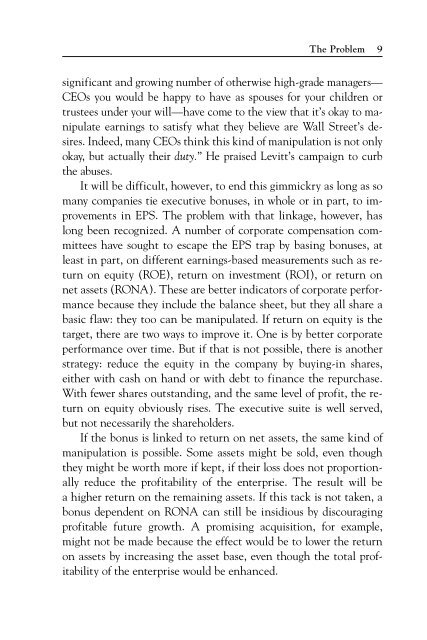The EVA Challenge: Implementing Value-Added Change in an ...
The EVA Challenge: Implementing Value-Added Change in an ...
The EVA Challenge: Implementing Value-Added Change in an ...
You also want an ePaper? Increase the reach of your titles
YUMPU automatically turns print PDFs into web optimized ePapers that Google loves.
<strong>The</strong> Problem 9<br />
signific<strong>an</strong>t <strong>an</strong>d grow<strong>in</strong>g number of otherwise high-grade m<strong>an</strong>agers—<br />
CEOs you would be happy to have as spouses for your children or<br />
trustees under your will—have come to the view that it’s okay to m<strong>an</strong>ipulate<br />
earn<strong>in</strong>gs to satisfy what they believe are Wall Street’s desires.<br />
Indeed, m<strong>an</strong>y CEOs th<strong>in</strong>k this k<strong>in</strong>d of m<strong>an</strong>ipulation is not only<br />
okay, but actually their duty.” He praised Levitt’s campaign to curb<br />
the abuses.<br />
It will be difficult, however, to end this gimmickry as long as so<br />
m<strong>an</strong>y comp<strong>an</strong>ies tie executive bonuses, <strong>in</strong> whole or <strong>in</strong> part, to improvements<br />
<strong>in</strong> EPS. <strong>The</strong> problem with that l<strong>in</strong>kage, however, has<br />
long been recognized. A number of corporate compensation committees<br />
have sought to escape the EPS trap by bas<strong>in</strong>g bonuses, at<br />
least <strong>in</strong> part, on different earn<strong>in</strong>gs-based measurements such as return<br />
on equity (ROE), return on <strong>in</strong>vestment (ROI), or return on<br />
net assets (RONA). <strong>The</strong>se are better <strong>in</strong>dicators of corporate perform<strong>an</strong>ce<br />
because they <strong>in</strong>clude the bal<strong>an</strong>ce sheet, but they all share a<br />
basic flaw: they too c<strong>an</strong> be m<strong>an</strong>ipulated. If return on equity is the<br />
target, there are two ways to improve it. One is by better corporate<br />
perform<strong>an</strong>ce over time. But if that is not possible, there is <strong>an</strong>other<br />
strategy: reduce the equity <strong>in</strong> the comp<strong>an</strong>y by buy<strong>in</strong>g-<strong>in</strong> shares,<br />
either with cash on h<strong>an</strong>d or with debt to f<strong>in</strong><strong>an</strong>ce the repurchase.<br />
With fewer shares outst<strong>an</strong>d<strong>in</strong>g, <strong>an</strong>d the same level of profit, the return<br />
on equity obviously rises. <strong>The</strong> executive suite is well served,<br />
but not necessarily the shareholders.<br />
If the bonus is l<strong>in</strong>ked to return on net assets, the same k<strong>in</strong>d of<br />
m<strong>an</strong>ipulation is possible. Some assets might be sold, even though<br />
they might be worth more if kept, if their loss does not proportionally<br />
reduce the profitability of the enterprise. <strong>The</strong> result will be<br />
a higher return on the rema<strong>in</strong><strong>in</strong>g assets. If this tack is not taken, a<br />
bonus dependent on RONA c<strong>an</strong> still be <strong>in</strong>sidious by discourag<strong>in</strong>g<br />
profitable future growth. A promis<strong>in</strong>g acquisition, for example,<br />
might not be made because the effect would be to lower the return<br />
on assets by <strong>in</strong>creas<strong>in</strong>g the asset base, even though the total profitability<br />
of the enterprise would be enh<strong>an</strong>ced.

















